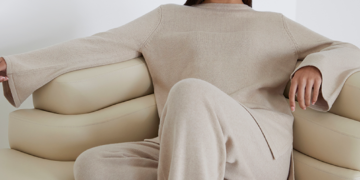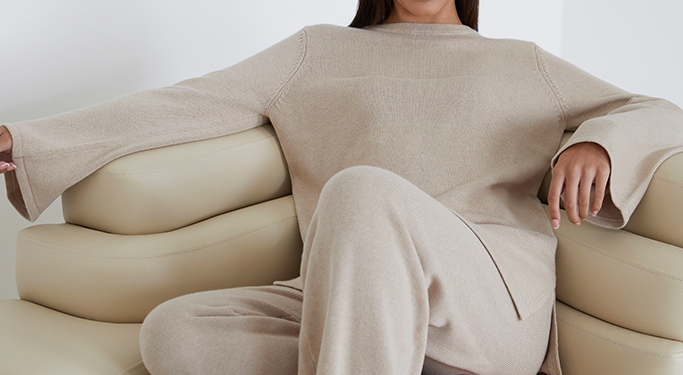Knitwear appears in the symphony of fashion as a canvas for a sustainable revolution as well as a means of clothing. This is the age of environmentally conscious knitting, when the yarns convey stories of artistry, coziness, and environmental responsibility. Beyond the clichés, this special fusion of coziness and environmental awareness elevates knitwear from its basic materials to the status of wearable art.
The Artistry of Timeless Knitwear
Knitwear, an ancient artistry passed through generations, has always been a testament to the craft of creating comfort. From the cozy embrace of grandmothers’ hand-knit sweaters to the intricate patterns of contemporary designers, knitwear transcends mere clothing, becoming a tactile expression of heritage and style.
Eco-Friendly Metamorphosis
Knitwear transforms into an environmentally friendly phenomena as people become more aware of the negative effects that fast fashion has on the environment. Not only has design changed, but materials and processes have carefully evolved as well, redefining the foundation of the fashion business.
Organic Fibers, Modern Luxuriance: Organic fibers are the lifeblood of environmentally friendly knitwear. Selecting eco-friendly materials like bamboo and organic cotton not only signifies a dedication to sustainability, but also a new chapter in contemporary luxury. These fibers redefine comfort against the skin; they are soft, breathable, and devoid of synthetic pesticides.
Chemical Alchemy: The conventional chemistry of textile manufacture is being rewritten by the eco-friendly knitwear movement. It’s a pledge to lessen the chemical footprint throughout the entire process, from dying to finishing. Wearing clothing becomes an environmentally conscious experience thanks to natural dyes and eco-friendly finishing techniques.
The cyclical fashion choreography invites you to join in the dance as vintage knitwear transforms into brand-new designs. By adopting recycling and upcycling techniques, brands give clothing a historical feel, promoting a circular economy that reduces waste and extends the life of each item.
Moral Webs Weaving Community: Making eco-friendly knit clothing is a group effort rather than a solitary one. Fair trade procedures guarantee that all parties—farmers and craftspeople alike—are treated with dignity and are fairly compensated. With this linked approach, a feeling of community is woven into each piece of clothing.
The Intersection of Comfort and Consciousness
Eco-friendly knitwear isn’t merely a fashion choice; it’s an intersection where comfort meets consciousness. This unique blend creates a narrative that extends beyond aesthetics, inviting wearers to be part of a story that embraces both personal comfort and global responsibility.
Eco-friendly knitwear enhances the sensory experience, creating a “Sensorial Symphony.” More than just a tactile delight, the feel of organic fibers against the skin becomes a purposeful decision that immerses wearers in the natural world and invites them to savor the sensory symphony of sustainable comfort.
Beyond Boundaries Aesthetics: Sustainability fosters rather than stifles creativity. Eco-friendly knitwear serves as a platform for creative style. Inspired by the possibilities presented by sustainable materials, designers craft unique pieces that push the boundaries of conscious fashion.
Versatile Styles for All Voices: The environmentally conscious knitwear movement is made up of many different voices. A wide variety of tastes are catered to by the styles, which span from sleek and modern designs to bohemian chic compositions. Every piece of clothing becomes a distinct expression, enabling wearers to uphold their morals without sacrificing their sense of style.
Fashion has become an educational tool in this eco-aware age. This is known as educational couture. Consumers are searching for brands that share their values as they become more conscious of how their decisions affect the environment. Because of this increased consciousness, there is a stronger bond between the user and their clothes, transforming them into educational tools.
Case Studies and Inspirations
The Ethical Elegance of Eileen Fisher: Eileen Fisher is a model for ethical fashion. Their knitwear creations are a seamless reflection of their dedication to sustainability. Eileen Fisher is a wonderful example of how fashion can be both fashionable and ecological since she uses organic materials and is committed to circular fashion ideas.
The Knitwear Adventure of Patagonia: Known for its outdoor philosophy, Patagonia incorporates environmental responsibility into their knitwear. Crafted using recycled fabrics, fair trade techniques, and cutting-edge technology, Patagonia’s knitwear keeps wearers warm while simultaneously making a positive impact on the environment.
Reimagining Reformation’s Style: Reformation adds a dash of eco-friendly flair to knitwear. Reformation uses eco-friendly materials like Tencel and recycled deadstock fabrics to create stylish knit pieces that are consistent with their commitment to sustainable fashion.
The Future Tapestry of Eco Knitwear
Technological marvels: Even more sustainable options are expected to be produced by the continuous research and development in textile technology. Knitwear production’s negative environmental effects will be further mitigated by developments in bio-based fibers and dying methods.
Collaborative Initiatives: The advancement of sustainable methods in the knitwear sector will be greatly aided by partnerships between fashion labels, environmental organizations, and educational institutions. Design professionals and customers will be better equipped to make decisions through workshops, seminars, and instructional programs.
Consumer-Led Transformation: Change will always be fueled by the power of the consumer. People will demand transparency, moral behavior, and environmentally friendly solutions as they become more aware of their impact on the environment. The adoption of eco-friendly practises by brands will be propelled by consumer advocacy.
In summary
In summary, the eco-friendly knitwear movement is a renaissance rather than merely an evolution of fashion. It turns knitwear from an article of clothing into a work of sustainable art. Beyond fads, this special meeting point of ease and consciousness invites wearers to participate in a story that prioritizes both individual wellbeing and societal duty. We become threads in a narrative that honors the environment, embraces comfort, and celebrates craftsmanship as we weave ourselves into the fabric of eco-friendly knitwear. It’s a deliberate commitment to creating a more beautiful and sustainable environment, not merely a choice in clothing.







































